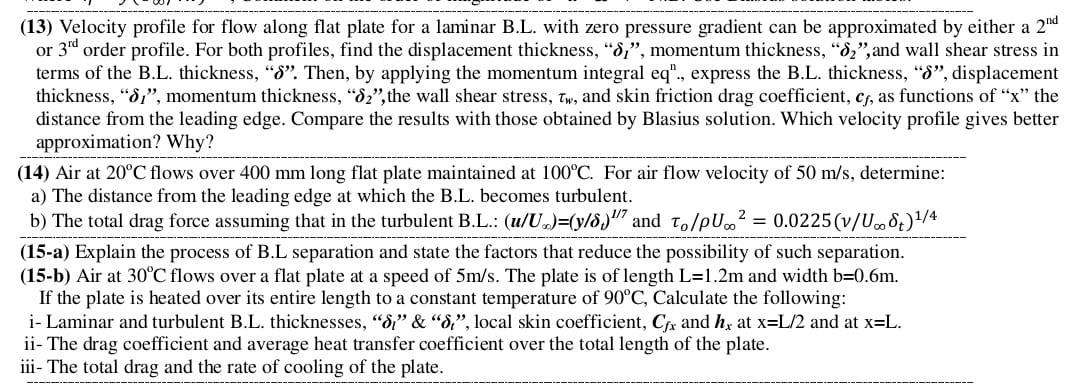Home /
Expert Answers /
Mechanical Engineering /
13-velocity-profile-for-flow-along-flat-plate-for-a-laminar-b-l-with-zero-pressure-gradient-can-pa343
(Solved): (13) Velocity profile for flow along flat plate for a laminar B.L. with zero pressure gradient can ...
(13) Velocity profile for flow along flat plate for a laminar B.L. with zero pressure gradient can be approximated by either a or order profile. For both profiles, find the displacement thickness, " , , momentum thickness, " ,', and wall shear stress in terms of the B.L. thickness, " '. Then, by applying the momentum integral eq ., express the B.L. thickness, " ", displacement thickness, " ", momentum thickness, " ,",the wall shear stress, , and skin friction drag coefficient, , as functions of "x" the distance from the leading edge. Compare the results with those obtained by Blasius solution. Which velocity profile gives better approximation? Why? (14) Air at flows over long flat plate maintained at . For air flow velocity of , determine: a) The distance from the leading edge at which the B.L. becomes turbulent. b) The total drag force assuming that in the turbulent B.L.: and (15-a) Explain the process of B.L separation and state the factors that reduce the possibility of such separation. (15-b) Air at flows over a flat plate at a speed of . The plate is of length and width . If the plate is heated over its entire length to a constant temperature of , Calculate the following: i- Laminar and turbulent B.L. thicknesses, " " \& " " ", local skin coefficient, and at x=L/2 and at x=L. ii- The drag coefficient and average heat transfer coefficient over the total length of the plate. iii- The total drag and the rate of cooling of the plate.
Expert Answer
13)For laminar flow along a flat plate with zero pressure gradient, the velocity profile can be approximated by either a 2nd or 3rd order profile. For both profiles, the displacement thickness, ?1, momentum thickness, ?2, and wall shear stress can be expressed in terms of the BL thickness, ?'.For a 2nd order profile: ?1/?' = 1.463 and ?2/?' = 2.066, and the wall shear stress is ?w = ?U/?'For a 3rd order profile: ?1/?' = 1.72 and ?2/?' = 2.59, and the wall shear stress is ?w = 1.5?U/?'Using the momentum integral equation, the BL thickness, ?, displacement thickness, ?1, momentum thickness, ?2, wall shear stress, ?w, and skin friction drag coefficient, cf, can be expressed as:?(x) = 5x/?(Re_x) ?1(x) = (1/?(Re_x))(1.721-0.167x/?(x))?(x) ?2(x) = (2/?(Re_x))(1.721-0.167x/?(x))?(x) ?w(x) = (0.664?(Re_x))?U(x) cf(x) = ?w(x)/(1/2?U^2(x))Where Re_x is the Reynolds number at distance x from the leading edge.Comparing the results with the Blasius solution, it can be seen that the 3rd order profile provides a better approximation, as it gives a closer match to the Blasius solution. This is because the 3rd order profile takes into account the curvature of the velocity profile near the wall, which the 2nd order profile does not.
